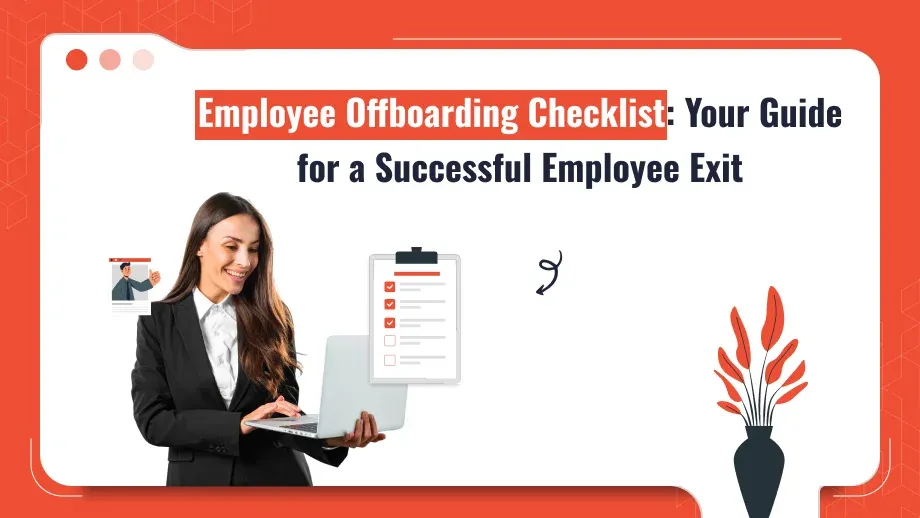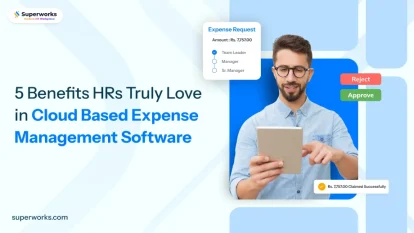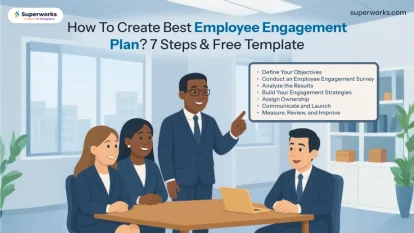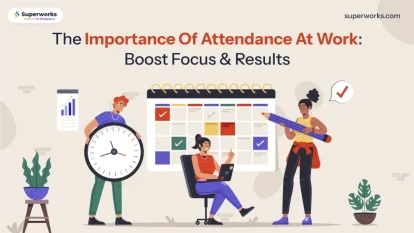
Employee offboarding is more than a goodbye. It is organized, thorough, and conducted to ensure a smooth exit and protect sensitive information with good treatment of the employees leaving. With an effective employee offboarding checklist, companies will be able to handle the systematic steps of the employee exit procedure of the employee while protecting company assets and good relationships with exiting employees. Here’s a step-by-step guide through every important action of a successful offboarding process.
What is Offboarding?
Offboarding refers to the employee exit management process from any organization. Whether it’s a resignation or a dismissal, an organized process at the time of employees leaving the organization is vital as it reduces disruption and holds company assets together to ensure an employee exit process in HR for the organization.
The final aim of the offboarding checklist for employees is a dignified exit of an employee while protecting the organization’s interests. This checklist typically includes steps like knowledge transfer, asset recovery, system access revocation, and documentation. By handling each component with utmost care, businesses can ensure safety, avoid data loss, and leave a good final impression.
Offboarding and. Onboarding – What’s the difference?
Onboarding and offboarding form the two bookends of the employee cycle. With onboarding getting the newly hired to start and mesh with the rest of a company, offboarding facilitates their exit, but doing this in a manner that remains respectful of both company requirements and those of employees will be key in ensuring there is no negativity around one’s leaving an organization and companies that excel at such Employee Onboarding and Offboarding practices benefit with better loyalty to their brands and an improved reputation.
In an integrated employee management strategy, the Pre-Onboarding Process, onboarding, and offboarding stages are considered smooth processes that maintain productivity, trust, and morale. A well-structured Pre-Onboarding phase helps new hires feel prepared and welcomed even before their first day, setting a positive tone for their journey. Good offboarding will often see employees leaving as potential advocates and sometimes even as candidates for future rehires. This balanced approach to the employee lifecycle is especially valuable in retaining a strong employer brand.
Why is Offboarding Important?
An organized employee offboarding checklist benefits both the organization and the departing employee. Here are key reasons why an offboarding process matters:
- Data Security: The offboarding process is clear and well-defined, ensuring that possible security issues such as revocation of access to systems and return of physical assets are prevented. When a person leaves, there is a need to take away all access to sensitive data and systems. In general, it helps eliminate the risks that might have resulted from a breach in access or unauthorized access. Those dealing with highly sensitive information or intellectual property face such risks.
- Knowledge Transfer: Departing employees often hold valuable knowledge. Documenting their tasks, processes, and contacts helps ensure that their responsibilities can be smoothly transitioned to remaining employees. A well-managed employee exit procedure enables the capture of critical knowledge, reducing disruption for the rest of the team.
- Positive Brand Image: A professional employee exit process leaves a positive impression on employees, even if they are moving to a competitor. Exiting employees who feel respected are more likely to recommend the company and may consider returning in the future. This goodwill contributes to a company’s brand and can influence how it is perceived by potential recruits.
- Legal Compliance: Offboarding ensures compliance with labor laws, including providing final pay, handling benefits, and completing necessary documentation. A clear offboarding process checklist minimizes the risk of legal disputes related to wages, benefits, and confidentiality agreements.
Looking to streamline your offboarding process?
how our HRMS solution ensures a seamless transition, keeping all essential tasks in one place. Start simplifying today!
Offboarding Process in 9 Steps
Below are nine detailed steps for a comprehensive employee offboarding checklist that helps facilitate an organized and respectful transition:
1. Announce the Departure
Transparency is key in offboarding. Announcing the employee’s or Merchant Onboarding departure to relevant team members and departments helps keep everyone informed, reducing gossip and speculation. A carefully crafted message, whether sent via email or announced at a meeting, ensures clarity. It should cover essential details like the final day, any workload changes, and steps for continuity. By addressing questions and setting clear expectations, companies maintain a cohesive team atmosphere during transitions.
2. Conduct Knowledge Transfer
Knowledge transfer is one of the most crucial components of the employee exit checklist. Departing employees should document ongoing projects, provide access to essential files, and share important contacts. A knowledge transfer session allows team members or a successor to shadow the existing employee, learning the intricacies of their daily tasks. This proactive approach maintains productivity and reduces the risk of errors in complex roles. Many companies use digital project management tools to track and save essential knowledge, streamlining the transition for everyone involved.
3. Recover Company Assets
Retrieving all company-issued items, from laptops to access cards, is essential for protecting company resources and reducing costs. Items like mobile phones, company credit cards, and even furniture should be accounted for, with each item documented in a checklist for assets. By following an organized asset recovery process, companies ensure accountability while avoiding unnecessary losses.
4. Revoke System Access
System access revocation protects sensitive data. Coordinate with IT to revoke the departing employee’s access to company networks, email accounts, software subscriptions, and shared drives. In roles that involve particularly sensitive information, it’s critical to also change passwords on any shared accounts and reset multi-factor authentication settings. The offboarding checklist is vital to safety and security, particularly when working in areas with stringent laws regarding data.
Download Employee Offboarding Checklist
Note: You can download directly from here and edit as per your need.
5. Process Final Payments and Benefits
Professional offboarding is an important process that includes finalizing wages and benefits, such as bonuses, unused vacation, and other accrued benefits, along with reimbursements. Timely and accurate payment of these items helps build trust, even if all benefits aren’t fully applicable. Offboarding also involves informing employees about their options concerning health insurance coverage or retirement benefits. Many companies, especially those with international operations, closely coordinate with HR and payroll to ensure all payments comply with local laws and corporate policies.
Leveraging SaaS onboarding software can further streamline this process, providing a seamless experience and ensuring compliance across various regions.
6. Conduct an Exit Interview
Exit interviews are an excellent chance for a feedback session on the strengths of the business as well as areas of improvement. They provide a clear and honest account of what the employee is experiencing and highlight issues that might not appear in daily processes. In an exit interview, be sure to ask open-ended questions for example:
- “What did you enjoy most and least about working here?”
- “Are there any processes you believe could be improved?”
- “What prompted this decision to leave the workplace?”
Exit interviews may occur in person, over distance, or via an e-mail survey, whichever choice the employee prefers. This feedback helps refine company practices and can even improve employee retention if common themes emerge.
7. Update Company Records and Remove from Directories
Once an employee departs, updating organizational records is crucial. Removing the employee from internal email groups, directories, and workflow tools prevents unauthorized access and clarifies responsibility assignments for remaining team members. Maintaining accurate directories and organizational charts aids communication and supports a structured workflow.
Integrating efficient onboarding & offboarding processes can further streamline these updates, ensuring smooth transitions and protecting organizational security as roles evolve.
8. Finalize Documentation
Completing all necessary documentation protects the company legally and administratively. This may include enforcing nondisclosure agreements, verifying noncompete clauses, and updating personnel files. Documented evidence is essential not only to meet compliance requirements but also to track an employee’s contributions and responsibilities. In regulated industries, securely storing this documentation helps avoid penalties and upholds ethical standards.
Using HRMS Payroll Software in India can streamline these processes, ensuring that all documentation is securely managed and easily accessible, thus enhancing legal compliance and administrative efficiency.
9. Maintain Post-Departure Engagement
A respectful offboarding process can lead to continued engagement with former employees through alumni networks, social media groups, or professional events. This relationship-building fosters goodwill and can even lead to re-engaging top talent. Some organizations invite alumni to mentorship programs or collaborate on industry events, promoting a supportive community. This connection also boosts the company’s reputation, as engaged former employees may become ambassadors, referring top candidates or new business.
Implementing HRMS software in India can further enhance this process by simplifying alumni engagement and streamlining communication, helping companies maintain valuable connections and foster a positive employer brand.
Common Offboarding Mistakes to Avoid
Some common errors while trying to execute the checklist during the employee offboarding checklist are bound to disrupt the flow of operations and pose a security risk. These are the mistakes and the solutions to avoiding them in detail below:
- Neglecting Knowledge Transfer: Failing to document tasks and insights can lead to knowledge gaps. Designating a time for knowledge-sharing sessions ensures that critical information isn’t lost.
- Forgetting to Recover Assets: Leaving assets uncollected can result in significant costs. Keeping a checklist guarantees that businesses pay attention to every point and eliminate replacing employees out of nowhere.
- Skipping the Exit Interview: This would enable one to understand the strengths and weaknesses in a workplace through an exit interview.. Without feedback, companies miss valuable insights for improvement.
- Delaying Final Payments or Benefits: Late or inaccurate payments create legal risks and can harm the company’s reputation. The prompt payment shows respect and helps maintain a positive relationship.
Conclusion:
In keeping an employee offboarding checklist should not neglect to bring order into this offboarding by keeping an eye out on things related to employee offboarding- such as transfer of knowledge, recovery assets, and finally revoked access or finalized pay to Best Practices Onboarding by building this to a safe place-where companies give this sense in their commitment that ensures such positive memory, it, therefore, remains good when being off boarded at last: it ensures it also pays for relationships as its results.
For a balanced lifecycle experience of an employee, formal Employee Onboarding and Offboarding practices support not only retention but also work culture for a stronger workforce.





